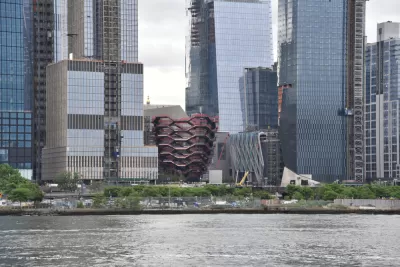When the Manhattan megadevelopment got its start, big data was a major part of Hudson Yards' marketing pitch. Now it's "probably the last thing we'll get to."

"New York's Hudson Yards was once billed as the country's first 'quantified community,'" Emily Nonko writes. "So where is the NASA-like mission control? Data collection and advanced infrastructure will still drive parts of Hudson Yards' operations, but not (yet) as first advertised."
In a pitch that segued with then-mayor Michael Bloomberg's luxe, tech-friendly vision for the city, Hudson Yards was supposed to be "a test bed for a network of sensors meant to provide constant updates to [developers] Related and Oxford. In a city known for grueling walk-ups and miserable subway commutes, data—it was promised—would make 'live, work, and play' (as the marketing lingo goes) easy and adaptable."
But in the intervening years, those developers "have been occupied with the not-so-insignificant task of building a neighborhood." Meanwhile, many of those smart city ambitions have been put on hold. "We concluded that big data is probably the last thing we'll get to. It'll be years from now before we're in that world," said Related Hudson Yards president Jay Cross.
Certain easy-to-implement smart systems are in place at Hudson Yards, including an app serving tenants, touch-screen kiosks for visitors, and fingerprint sensors for office workers. But even so, Nonko asks, "If Hudson Yards—with a seemingly infinite budget and a blank slate—couldn't build it, who can?" And as data collection stirs controversy at other smart city hotspots like Sidewalk Labs' Quayside, does that vision even reflect what people want?
FULL STORY: Hudson Yards Promised a High-Tech Neighborhood—It Was a Greater Challenge Than Expected

Alabama: Trump Terminates Settlements for Black Communities Harmed By Raw Sewage
Trump deemed the landmark civil rights agreement “illegal DEI and environmental justice policy.”

Planetizen Federal Action Tracker
A weekly monitor of how Trump’s orders and actions are impacting planners and planning in America.

Why Should We Subsidize Public Transportation?
Many public transit agencies face financial stress due to rising costs, declining fare revenue, and declining subsidies. Transit advocates must provide a strong business case for increasing public transit funding.

Understanding Road Diets
An explainer from Momentum highlights the advantages of reducing vehicle lanes in favor of more bike, transit, and pedestrian infrastructure.

New California Law Regulates Warehouse Pollution
A new law tightens building and emissions regulations for large distribution warehouses to mitigate air pollution and traffic in surrounding communities.

Phoenix Announces Opening Date for Light Rail Extension
The South Central extension will connect South Phoenix to downtown and other major hubs starting on June 7.
Urban Design for Planners 1: Software Tools
This six-course series explores essential urban design concepts using open source software and equips planners with the tools they need to participate fully in the urban design process.
Planning for Universal Design
Learn the tools for implementing Universal Design in planning regulations.
Caltrans
Smith Gee Studio
Institute for Housing and Urban Development Studies (IHS)
City of Grandview
Harvard GSD Executive Education
Toledo-Lucas County Plan Commissions
Salt Lake City
NYU Wagner Graduate School of Public Service





























